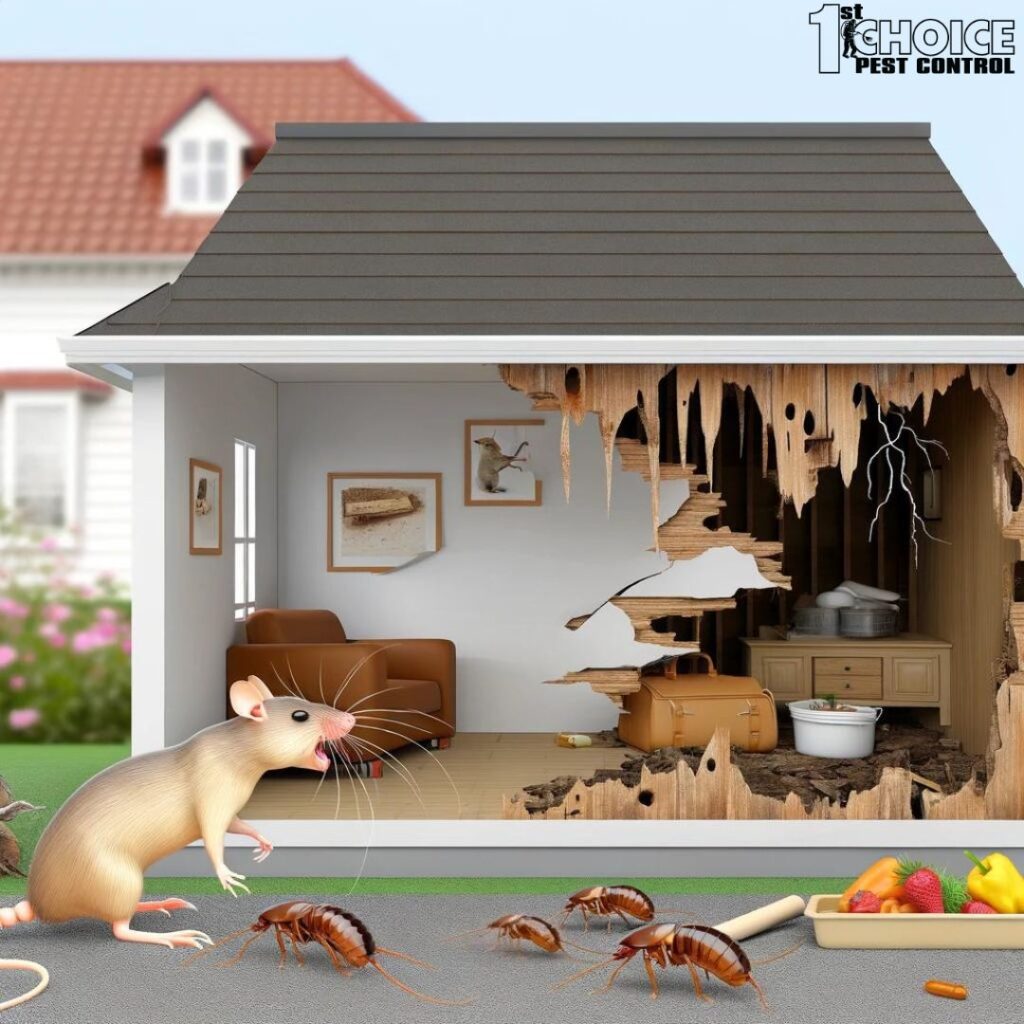The Price of Overlooking Pest Infestations: Understanding the Associated Risks and Damages
Pests are often dismissed as mere annoyances, a part of everyday life that can be swatted away or trapped and forgotten. This casual attitude, however, underestimates the serious risks and damages that pests can cause if their presence is ignored. From the silent spread of disease to the unseen degradation of a home’s very foundation, the consequences of overlooking pest problems can be far-reaching and significant. In this blog, we delve into the myriad ways pests can impact your health, your home, and your wallet. We aim to shed light on the importance of recognizing and addressing pest infestations promptly, not just for the sake of immediate comfort but for long-term safety and financial well-being. Understanding the true cost of ignoring pest problems is the first step towards safeguarding your property and health against these unwelcome invaders.
Health Risks Associated with Common Household Pests
Household pests are not merely an inconvenience; they are carriers of a range of diseases and health risks that can seriously affect the well-being of those living in infested environments. Understanding the health implications associated with common pests is crucial for maintaining a healthy home.
Rodents, such as mice and rats, are notorious for spreading diseases like Hantavirus, leptospirosis, and salmonellosis through their urine, droppings, and saliva. These diseases can lead to severe health issues, including respiratory problems, fever, and in some cases, life-threatening conditions. The mere presence of rodents can also exacerbate allergy and asthma symptoms, especially in children.
Cockroaches are another common household pest with significant health risks. They are known to carry bacteria such as E. coli and Salmonella on their bodies, which can contaminate food surfaces and lead to food poisoning. Moreover, cockroach droppings, saliva, and shedding body parts can trigger allergies and asthma, particularly in urban areas where cockroach infestations are more prevalent.
Mosquitoes are perhaps the most infamous carriers of disease, responsible for spreading Zika virus, West Nile virus, Chikungunya virus, dengue, and malaria. While not all mosquitoes carry these diseases, the health risks associated with mosquito bites make effective mosquito control a critical concern for homeowners, especially in regions where these diseases are more common.
The health risks posed by these and other pests underscore the importance of taking pest infestations seriously. Ignoring the presence of pests in your home not only puts your health at risk but also the health of your family and pets. Prompt action and effective pest control measures are essential for preventing the spread of diseases and ensuring a safe, healthy living environment.
Structural Damage Caused by Pests
Ignoring pest problems can lead to significant structural damage to your home, often occurring silently and unseen until it becomes severe and costly to repair. Two of the most destructive pests in this regard are termites and carpenter ants, which can compromise the integrity of your home from within.
Termites are often called the “silent destroyers” because of their ability to chew through wood, flooring, and even wallpaper undetected. They primarily feed on cellulose, a component found in wood, making every home a potential source of food. Termites cause billions of dollars in structural damage each year, and because most homeowners’ insurance does not cover termite damage, the financial burden falls squarely on the homeowner. Early detection and treatment are key to preventing termites from causing irreparable damage to your property.
Carpenter ants also pose a significant threat to wooden structures in your home. Unlike termites, carpenter ants do not eat the wood but excavate it to create nests, weakening structural elements over time. The damage from carpenter ants can be extensive, as they tend to prefer moist, decaying wood, often a result of water leaks or poor ventilation. This preference means that in addition to the structural damage, there may also be underlying issues with moisture that need to be addressed.
Other pests, such as rodents, can also cause structural damage by gnawing on wires, insulation, and structural components, which can lead to electrical fires, water leaks, and further deterioration of your home’s integrity.
The structural damage caused by pests not only affects the safety and security of your home but also its aesthetic value and comfort. The key to preventing these pests from causing damage is regular inspections and timely pest control interventions. Recognizing the early signs of infestation and taking swift action can save homeowners from the substantial costs and headaches associated with repairing structural damage caused by pests.
Financial Implications of Unaddressed Pest Infestations
Ignoring pest problems is a decision that can lead to severe financial consequences over time. The costs associated with unaddressed pest infestations extend far beyond the immediate discomfort and annoyance they may cause. For instance, termite infestations, known for their silent and destructive nature, can result in repair bills that run into the thousands, if not tens of thousands, of dollars. These insects can compromise the structural integrity of a property, leading to extensive and costly repairs that could have been prevented with early detection and intervention.
Rodents, such as rats and mice, can also inflict significant damage to your home, chewing through electrical wiring, insulation, and even plumbing, which can lead to further expensive repairs like electrical faults and water damage. Similarly, the presence of cockroaches and other pests can necessitate professional cleaning and restoration services, especially in cases of severe infestations where they have contaminated surfaces or food supplies.
The cost-effectiveness of early pest control interventions cannot be overstated. Investing in preventative measures, such as sealing entry points, maintaining a clean and clutter-free environment, and scheduling regular pest inspections, can save homeowners a significant amount of money in the long run. Immediate treatment at the first sign of an infestation is crucial to preventing the spread of pests and avoiding the escalation of damage and associated costs.
The Impact on Property Value and Saleability
The presence of pests can do more than just cause physical damage to your property; it can also significantly impact its value and attractiveness to potential buyers. When it comes time to sell, evidence of pest infestations or the damage they’ve caused can be a major red flag for prospective buyers, potentially leading to reduced offers or difficulty selling the property altogether.
A pest-free home, on the other hand, not only commands a higher market value but also appeals more to buyers, ensuring a smoother and quicker sale process. Regular pest control maintenance is crucial for homeowners looking to preserve or enhance their property’s value. Demonstrating a commitment to pest management can also be a selling point, providing peace of mind to buyers concerned about the long-term care and condition of their potential new home.
In addition to maintaining a regular pest control schedule, homeowners should consider a professional pest inspection prior to listing their property. This proactive approach can identify and address any issues before they become obstacles in the selling process, further ensuring that the property’s value is maximized and its saleability is not compromised by avoidable pest-related problems.
Ultimately, the financial implications of ignoring pest infestations are clear. From the costs associated with repairing damage to the potential impact on property value and saleability, the risks are significant. Investing in regular pest control and maintenance is not just a measure to protect your home—it’s a strategic decision to safeguard your financial investment and ensure the long-term value and appeal of your property.
Tips for Recognizing Early Signs of Pest Problems
Being vigilant and recognizing the early signs of pest problems can prevent minor issues from escalating into major infestations. Look out for droppings, signs of nesting, property damage (such as gnawed wires or furniture), and unexplained health symptoms among household members. Regularly inspect hidden areas and potential entry points for pests, such as cracks in the foundation, gaps around doors and windows, and damp areas prone to attracting pests. Early detection coupled with professional pest control services can effectively manage pest populations and prevent future infestations.
Conclusion:
The risks and damages associated with ignoring pest problems highlight the importance of professional pest control services. DIY measures may offer temporary relief, but without the expertise and resources of professionals, it’s challenging to achieve a long-term solution. Engaging with a reputable pest control provider, like 1st Choice Pest Control, ensures that your home is protected against pests through safe, effective, and sustainable methods. Professionals can offer tailored solutions based on your specific situation, ensuring that pests are not only removed but that measures are in place to prevent their return.
Don’t let pests put your health, home, and finances at risk. If you suspect a pest problem, or haven’t had an inspection recently, now is the time to act. Contact 1st Choice Pest Control for a comprehensive inspection and customized pest management plan. Protect your home, your family, and your investment by choosing the proactive approach to pest control.



 Service Request
Service Request